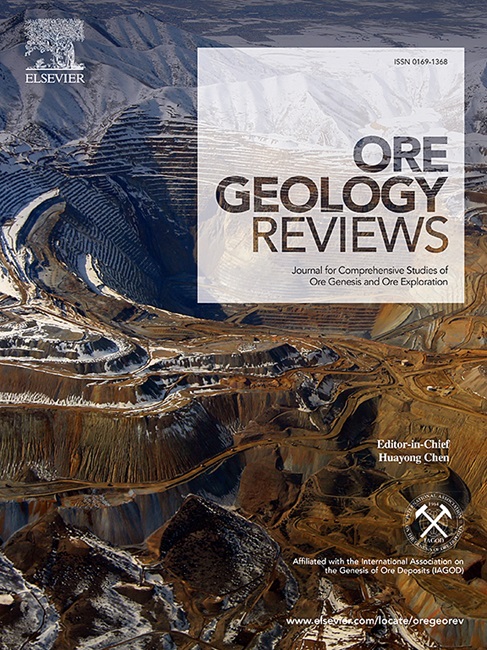The role of carbonatite-silicate liquid immiscibility in the global large carbonatite-associated REE deposits (CARDs): New insight from the trace element
IF 3.2
2区 地球科学
Q1 GEOLOGY
引用次数: 0
Abstract
More than 600 carbonatites worldwide are spatially and temporally associated with silicate rocks, which contributes to the formation of carbonatite-silicate complexes originating from mantle. However, only a minority of these carbonatites evolve into large to giant rare earth element (REE) deposits. The formation mechanisms of carbonatite-associated REE deposits (CARDs) are primarily attributed to liquid immiscibility. Nonetheless, experimental petrology has discussed the REE distribution coefficients (DCarb/Sil) during liquid immiscibility, yet lacks quantification of the difference of the natural deposits. Moreover, the magma source of carbonatites and silicate rocks from these deposits is derived from the mantle, and the geochemical indexes can support further evidence. This study focuses on the globally significant large carbonatite-associated REE deposits, specifically six deposits involving Mianning-Dechang REE belt (Maoniuping, Dalucao, Muluozhai, Lizhuang), Bayan Obo, and Mountain Pass, to investigate the characteristics of the magma source and origin of carbonatite-silicate complexes through bulk-rock geochemistry. The Y/Ho values of carbonatites and silicate rocks from these deposits, except for Lizhaung, are similar to mantle value, indicating a mantle-derived origin. Except for Mountain Pass and Maoniuping carbonatites, high Nb/Ta ratios in the other samples indicate geochemical decoupling during liquid immiscibility, although they have similar charge and ionic radius. To verify the liquid immiscibility, we utilized the discernable geochemical indexes (e.g., Ba/Mn, Ba/La) based on their well-constrained partitioning behaviors in different magma compositions. The results show that the compositions of carbonatites and silicate rocks in Dalucao are strictly accordant with those confirmed by experiments, whereas others deviate more or less. This further suggests that subsequent magma fractionation or fluid-mediated works on the other five deposits and compositionally covers up the evidence of liquid immiscibility. To trace carbonatite-silicate liquid immiscibility in these deposits, we propose the deviation coefficient Ƙ via a comparison on the difference of REE distribution coefficients (DCarb/Sil) between experimental results and natural deposits. The examined results show that Ƙ values for Maoniuping, Dalucao, Muluozhai, Bayan Obo Mg-carbonatite and Ca-carbonatite are close to 0, while the Ƙ values for Lizhuang, Bayan Obo Fe-carbonatite and Mountain Pass show the opposite trend. Utilizing the C-O isotopic composition from previous studies and immiscible deviation coefficient Ƙ, the occurrence of immiscibility in Maoniuping, Dalucao, Muluozhai, Bayan Obo Mg-carbonatite and Ca-carbonatite has been confirmed. Based on previous research, we believe that liquid immiscibility not only facilitates pre-enrichment of rare earth elements but also contributes to subsequent REE mineralization.

碳酸盐岩-硅酸盐液体不溶性在全球大型碳酸盐岩相关稀土金属矿床(CARDs)中的作用:痕量元素的新见解
全世界有 600 多处碳酸盐岩在空间和时间上与硅酸盐岩相关,这有助于形成源自地幔的碳酸盐岩-硅酸盐复合体。然而,这些碳酸盐岩中只有少数演变成大型至巨型稀土元素(REE)矿床。碳酸盐岩相关稀土元素矿床(CARDs)的形成机制主要归因于液体不溶性。然而,实验岩石学讨论了液态不溶性过程中的稀土元素分布系数(DCarb/Sil),但缺乏对天然矿床差异的量化。此外,这些矿床的碳酸盐岩和硅酸盐岩的岩浆源来自地幔,地球化学指标可以进一步证明这一点。本研究以全球重要的大型碳酸盐岩伴生REE矿床为研究对象,特别是涉及绵宁-德昌REE矿带(毛牛坪、大路草、木落寨、李庄)、巴彦敖包和山口的六个矿床,通过块岩地球化学研究碳酸盐岩-硅酸盐岩复合体的岩浆源特征和成因。这些矿床中的碳酸盐岩和硅酸盐岩的Y/Ho值除黎庄外都与地幔值相近,表明其来源于地幔。除了山口碳酸盐岩和茅牛坪碳酸盐岩外,其他样品中的Nb/Ta比值较高,表明在液相不溶性过程中地球化学脱钩,尽管它们具有相似的电荷和离子半径。为了验证液相不溶性,我们根据不同岩浆成分中具有良好约束的分区行为,利用了可辨别的地球化学指标(如 Ba/Mn、Ba/La)。结果表明,大芦草碳酸盐岩和硅酸盐岩的成分与实验所证实的成分完全一致,而其他成分或多或少存在偏差。这进一步表明,岩浆分馏或流体介导作用对其他五个矿床产生了影响,并从成分上掩盖了液体不溶性的证据。为了追溯这些矿床的碳酸盐岩-硅酸盐液相不溶性,我们通过比较实验结果与天然矿床的稀土元素分布系数(DCarb/Sil)之差,提出了偏离系数Ƙ。研究结果表明,毛牛坪、大芦草、木落寨、巴彦奥博镁碳酸盐岩和钙碳酸盐岩的Ƙ值接近于0,而李庄、巴彦奥博铁碳酸盐岩和山口的Ƙ值则呈现相反的趋势。利用前人研究的 C-O 同位素组成和不溶偏离系数Ƙ,证实了毛牛坪、大路草、木落寨、巴彦鄂博镁碳酸盐岩和钙碳酸盐岩中存在不溶性。根据以往的研究,我们认为液相不溶性不仅有利于稀土元素的预富集,还有助于随后的稀土矿化。
本文章由计算机程序翻译,如有差异,请以英文原文为准。
求助全文
约1分钟内获得全文
求助全文
来源期刊

Ore Geology Reviews
地学-地质学
CiteScore
6.50
自引率
27.30%
发文量
546
审稿时长
22.9 weeks
期刊介绍:
Ore Geology Reviews aims to familiarize all earth scientists with recent advances in a number of interconnected disciplines related to the study of, and search for, ore deposits. The reviews range from brief to longer contributions, but the journal preferentially publishes manuscripts that fill the niche between the commonly shorter journal articles and the comprehensive book coverages, and thus has a special appeal to many authors and readers.
 求助内容:
求助内容: 应助结果提醒方式:
应助结果提醒方式:


